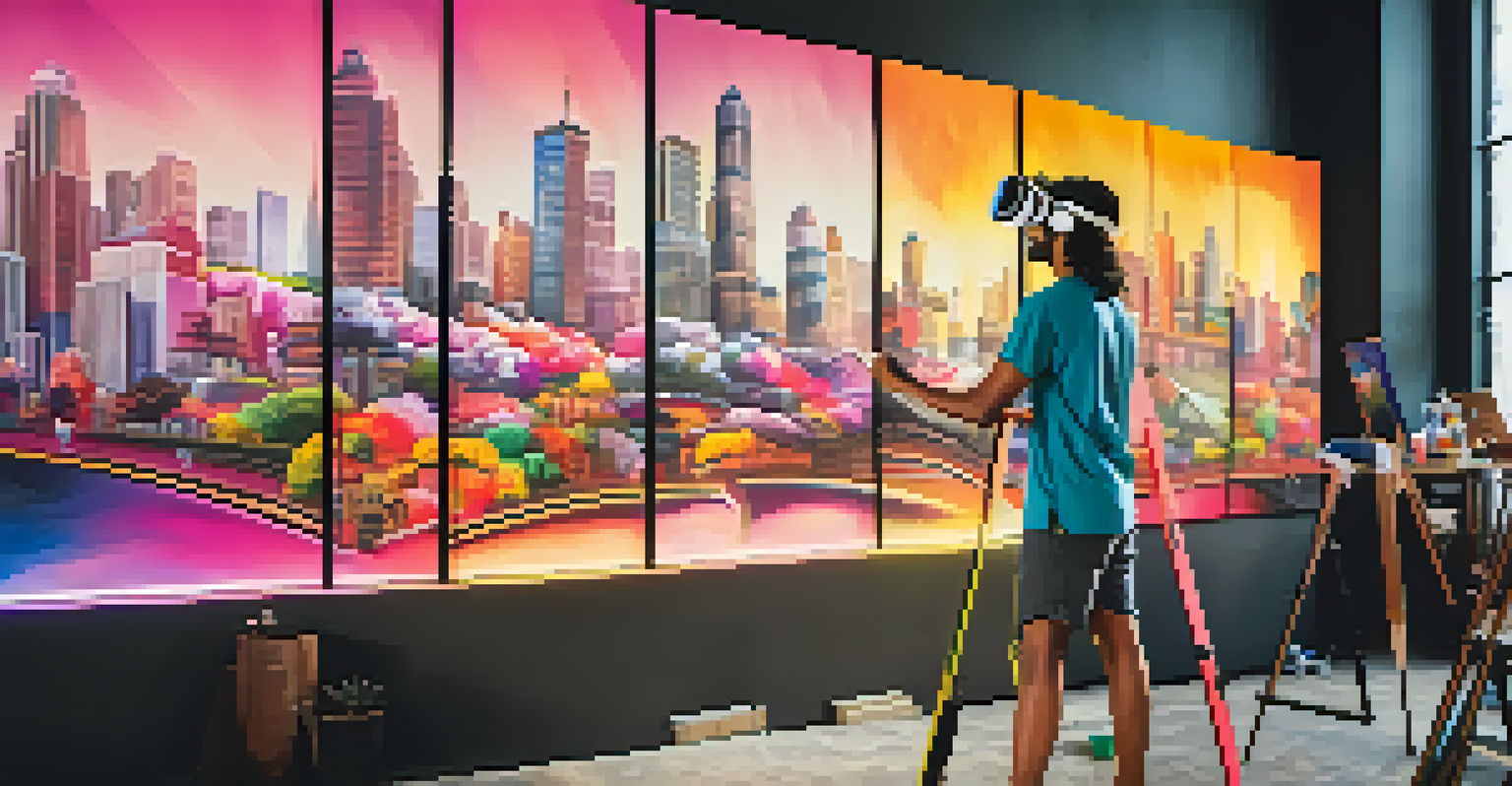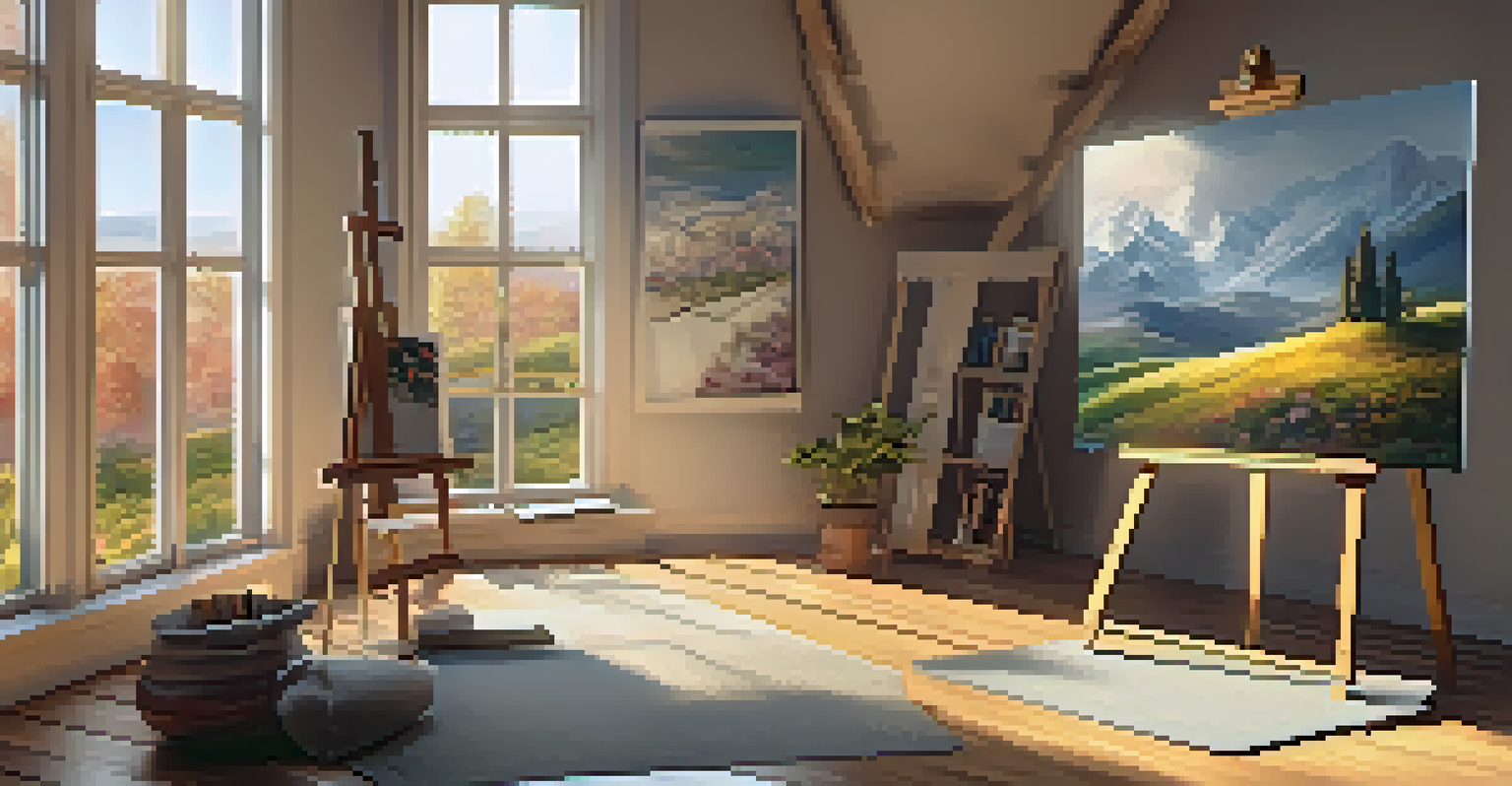Art Therapy and Virtual Reality: Healing Through Digital Creativity

Understanding Art Therapy and Its Benefits
Art therapy is a therapeutic practice that uses creative expression to help individuals process emotions and experiences. It allows people to communicate feelings that might be difficult to articulate using words. Through mediums like painting, drawing, or sculpting, individuals can explore their inner thoughts and feelings in a safe and supportive environment.
Art enables us to find ourselves and lose ourselves at the same time.
The benefits of art therapy are extensive; it can reduce anxiety, improve self-esteem, and promote emotional healing. For those struggling with trauma or mental health issues, creating art can serve as a powerful tool for self-discovery and catharsis. By engaging in the creative process, individuals often find clarity and insight into their personal challenges.
Moreover, art therapy is adaptable and can be tailored to suit various age groups and needs. Whether working with children or adults, therapists can create personalized sessions that encourage participants to express themselves freely. This flexibility makes art therapy an appealing option for many seeking emotional support.
The Rise of Virtual Reality in Therapy
Virtual reality (VR) has emerged as an innovative tool in various therapeutic settings, providing immersive experiences that enhance traditional methods. By simulating real-world environments, VR can help individuals confront fears, practice social skills, or explore personal narratives in a controlled space. This technology allows for engaging and dynamic interactions that can be more impactful than conventional therapy alone.

In particular, VR has shown promise in treating anxiety disorders, PTSD, and phobias. For example, a person with a fear of heights can gradually experience heights in a virtual setting, helping them to build confidence and coping strategies. This gradual exposure, combined with therapeutic guidance, can lead to significant breakthroughs in overcoming anxiety.
Art Therapy Enhances Emotional Healing
Art therapy provides a creative outlet for individuals to process emotions and experiences, leading to reduced anxiety and improved self-esteem.
Additionally, VR can create opportunities for accessibility, allowing individuals who may have mobility limitations or geographic barriers to engage in therapeutic activities. This advancement opens doors for more people to access mental health support, making therapy more inclusive and effective.
Combining Art Therapy and Virtual Reality
The intersection of art therapy and virtual reality presents exciting possibilities for healing and creativity. By incorporating VR into art therapy sessions, therapists can create immersive environments where clients can express themselves artistically without the limitations of physical space. Imagine painting a mural on a virtual city wall or sculpting in a serene, digitally rendered garden.
Virtual reality is the ultimate canvas for the artist; it allows for limitless exploration of creativity and emotion.
This combination not only enhances creativity but also provides a unique way for individuals to explore their emotions. The immersive nature of VR can intensify the therapeutic experience, allowing clients to engage with their feelings on a deeper level. For many, this added layer of interaction can lead to more profound insights and breakthroughs.
Moreover, the virtual aspect can help reduce the stigma often associated with traditional therapy settings. Clients can feel more at ease expressing themselves in a digital environment, where they can experiment with art forms freely. As a result, this innovative approach can foster a sense of community and shared experience among participants, enhancing the overall therapeutic process.
Case Studies: Success Stories in VR Art Therapy
Several case studies highlight the effectiveness of combining art therapy with virtual reality. For instance, a program focused on veterans with PTSD used VR art therapy to help participants visualize and process traumatic experiences through creative expression. Many reported significant improvements in their emotional well-being and coping strategies after engaging in these sessions.
Another example involved children with autism spectrum disorder, who utilized VR art therapy to develop social skills and emotional regulation. The interactive nature of the technology allowed them to practice social scenarios in a safe environment, leading to increased confidence and communication skills. Parents and therapists noted remarkable progress in the children's ability to articulate their feelings and engage with others.
VR Revolutionizes Therapeutic Practices
Virtual reality offers immersive experiences that help individuals confront fears and develop coping strategies in a controlled environment.
These success stories demonstrate that the fusion of art therapy and VR can create transformative experiences for individuals seeking healing. As more research emerges, it’s clear that this innovative approach holds great potential for diverse populations and therapeutic needs.
Challenges and Considerations in Implementation
While the integration of art therapy and virtual reality is promising, it does come with challenges that need to be addressed. One major consideration is the cost and accessibility of VR technology. Not all therapy centers may have the resources to invest in high-quality VR equipment, which could limit availability for some clients.
Additionally, therapists must be adequately trained in both art therapy techniques and the use of VR technology. This dual expertise is crucial for ensuring that therapeutic goals are met while utilizing the innovative tools effectively. Ongoing training and support will be necessary to keep pace with advancements in technology and therapeutic practices.
Finally, ethical considerations surrounding privacy and data security in virtual environments must be taken into account. Therapists need to ensure that clients feel safe and secure while engaging in VR sessions. Building trust is essential for fostering a successful therapeutic relationship, and addressing these concerns is vital for the responsible implementation of VR art therapy.
The Future of Art Therapy in a Digital World
As technology continues to evolve, the future of art therapy looks increasingly digital. The integration of virtual reality and other digital tools into therapeutic practices could redefine how individuals engage with their emotions and explore their creativity. This shift may lead to new methods of healing that resonate with the digital generation.
Moreover, the potential for remote therapy sessions means that individuals can access support from the comfort of their own homes. This flexibility could expand the reach of art therapy, making it more accessible to those who may have previously faced barriers to treatment. The combination of digital creativity and emotional healing may open new avenues for personal growth and connection.
Combining Art and VR for Innovation
The fusion of art therapy and virtual reality creates unique opportunities for expression and healing, making therapy more engaging and accessible.
Looking ahead, ongoing research and collaboration between artists, therapists, and technologists will be essential for maximizing the benefits of this innovative approach. By sharing insights and experiences, the field can continue to evolve, ensuring that art therapy remains relevant and effective in a rapidly changing world.
Conclusion: Embracing Digital Creativity for Healing
In conclusion, the integration of art therapy and virtual reality offers exciting possibilities for emotional healing and creative expression. By embracing digital creativity, individuals can explore their feelings in ways that were previously unimaginable. This innovative approach has the potential to transform therapeutic practices and enhance the overall experience for clients.
As we continue to witness advancements in technology and therapy, it's essential to remain open to new ideas and methods. The fusion of art and virtual reality not only provides a unique outlet for expression but also promotes healing and connection in a digital age. Individuals seeking support can find hope and inspiration in these evolving practices.

Ultimately, the journey of healing through art and technology is just beginning. By harnessing the power of creativity in digital spaces, we can pave the way for a brighter future in mental health care, where everyone has the opportunity to express themselves and heal.